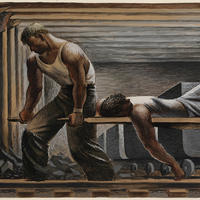More about Fletcher Martin
Works by Fletcher Martin

Contributor
Some people just know when school’s not right for them.
Fletcher Martin was one of those people. He dropped out of high school when he was 15. Smart guy! Imagine the kind of soul-crushing debt he managed to avoid. Well, you know what I’m talking about. You don’t need to imagine squat. So for all those brilliant people who skipped a conventional education and proved everyone wrong, give it up for your patron saint Fletcher Martin.
Fletcher was a '00s baby (albeit a century too early, 1904), a 20th century guy. The stork dropped him off with the Martins in Palisades, Colorado. Mr. Clinton Howard Martin, Fletcher’s dad, was in the newspaper biz. He was what they call a turnaround boss. Newspapers with one foot in the grave would frantically appeal to Mr. Martin to work his magic. As a consequence, his son was a printer by the time he was 12.
Fletcher was a hustler. After quitting school he worked as a lumberjack, and a professional boxer. This guy was a rebel without a cause. He even joined the Navy to see where that led him, and he wasn’t going to let being only 17 stop him. He lied about his age and came aboard anyway. He spent 3 years in the Navy, touring the countries south of the Equator.
After his military stint, Fletcher returned to North America and started working as a printer in Los Angeles. He worked at Earl Hays Printer, or the Earl Hays Press, which is still there. They helped Fletcher get his paintings printed. Employee benefits at EHP don’t seem too bad for a struggling artist.
In 1930, Fletcher started painting with oils and then got into murals in a big way. There is a Hollywood twist in here, an event, a turning point, that slingshots Fletcher into the world of art. In 1931, David Alfaro Siqueiros, the great Mexican muralist, comes down to LA to paint a mural at Dudley Murphy’s estate. Guess who got to assist him? Fletcher applied for the job and got it.
Siqueiros and Diego Rivera started the tradition of Mexican muralism together. Fletcher was learning from the best, not just how to paint, but what to paint: everything political. His paintings carry traces of Siqueiros' palette, and some of his politics too.
Fletcher also painted people fighting, playing, losing, getting drunk. He painted people as they moved, as they fell, as they got up again. Fletcher painted what he saw. That’s probably why LIFE magazine sent him to North Africa as their artist-correspondent during World War II. He even made the cover.
With every Hollywood star comes a string of bad breakups. Fletcher was married five times, and most of them ended badly. The last one, to Jean Sigsbee Small, was the one that stuck. She was a novelist who convinced Martin to move to Mexico. They lived there for over 12 years together until Martin died in 1979.
Sources
- “Fletcher Martin Biography: Annex Galleries Fine Prints.” Fletcher Martin Biography | Annex Galleries Fine Prints. Accessed October 31, 2019. https://www.annexgalleries.com/artists/biography/1506/Martin/Fletcher.
- Waggoner, Walter H. “Fletcher Martin, Artist of Action.” The New York Times. The New York Times, June 1, 1979. https://www.nytimes.com/1979/06/01/archives/fletcher-martin-artist-of-a….
- Hart, Arthur. “Idaho History: Fletcher Martin Was a Painter Who Loved Action and Adventure.” idahostatesman. Idaho Statesman, August 15, 2015. https://www.idahostatesman.com/news/northwest/idaho/history/article4156….
- “Fletcher Martin Modernist Studio Ceramic for Stonelain, Matador.” For Sale at 1stdibs. Accessed November 1, 2019. https://www.1stdibs.com/furniture/dining-entertaining/ceramics/fletcher….
- “Fletcher Martin: LACMA Collections.” Fletcher Martin | LACMA Collections. Accessed October 31, 2019. https://collections.lacma.org/node/166450.
- “Fletcher Martin (1904-1979).” Fletcher Martin. Accessed November 1, 2019. https://www.usbr.gov/museumproperty/art/biomart.html.
- “Fletcher Martin.” Wikipedia. Wikimedia Foundation, July 28, 2019. https://en.wikipedia.org/wiki/Fletcher_Martin.
Featured Content
Here is what Wikipedia says about Fletcher Martin

Fletcher Martin (April 19, 1904 – May 30, 1979) was an American painter, illustrator, muralist and educator. He is best known for his images of military life during World War II and his sometimes brutal images of boxing and other sports.
Check out the full Wikipedia article about Fletcher Martin











